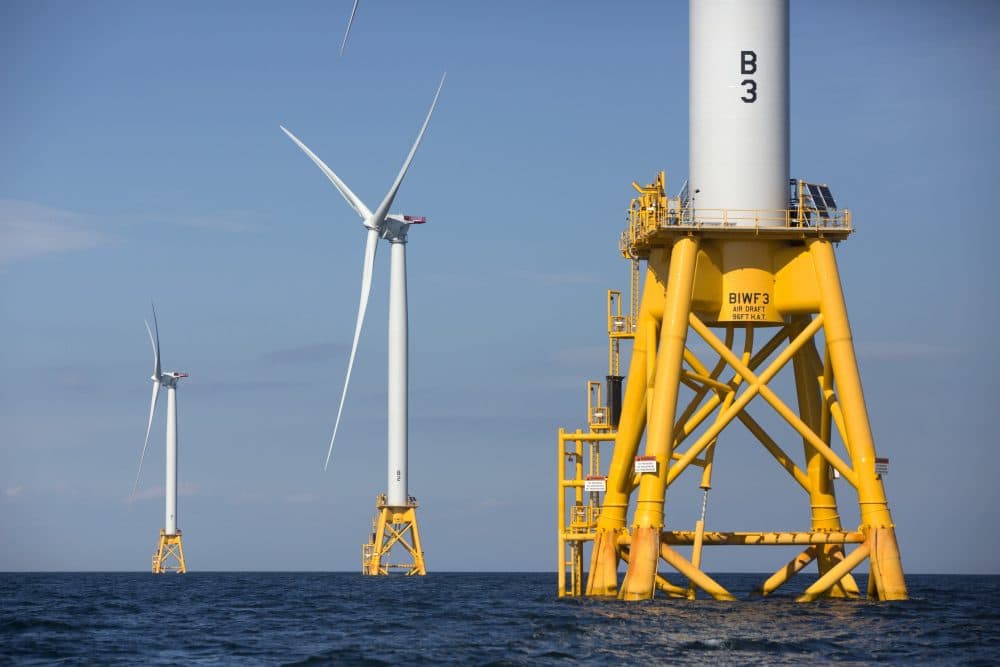Advertisement
Commentary
Massachusetts Could Win Big In Offshore Wind Energy

When the Massachusetts Legislature committed to building the first large-scale offshore wind farm in the Americas 18 months ago, the state became the front-runner in a race to foster an industry with potential for dynamic growth.
Now, as more states join the offshore wind chase, that leadership position is in doubt. And the economic stakes are high.
Across the nation, states are exploring alternatives to fossil fuels for the generation of electricity. In the Northeast, state leaders have recognized the opportunity in the steady winds that blow off their coasts. They’re hoping to replicate the success of offshore wind projects in Europe, where the industry has been delivering clean energy for more than two decades.
Rhode Island’s five-turbine pilot project off Block Island began producing power in 2016, the same year Massachusetts strode forward with an ambitious plan to build wind farms capable of powering more than 750,000 homes. In February, Connecticut jumped into the race, soliciting bids to bring a modest wind farm online off its shores by 2025.
[O]ver the next few years, the need for efficiency will drive the industry to consolidate, and a small number of regional hubs will emerge.
The activity isn’t confined to New England. In January, New York Gov. Andrew Cuomo introduced an offshore wind master plan with 50 percent more power capacity than the Massachusetts plan. Just days later, newly elected New Jersey Gov. Chris Murphy revived his state’s languishing offshore wind program, which now calls for more than twice the output of ours. Meanwhile, Maryland has already announced contracts for a substantial wind farm to be operational in 2021 (although they’re having their own Cape Wind moment down there), and Virginia is in the game, too.
So what does all this competition mean for Massachusetts?
For the moment, we’re focused on a different competition, one within our borders. In April, the winner (or winners) of the contracts for the first tranche of the state’s 10-year procurement objective will be announced. This race within a race is between three developers, each of them a partnership between a builder of wind turbines and a company specializing in transmission. And, as you’d expect, each is making claims of more expertise, better technology and greater jobs potential.
Regardless of which developers prevail in the Massachusetts competition, the stage will be set for a power struggle between the states on the Eastern Seaboard. Selling the idea of offshore wind has always relied not only on its promise of clean energy but heavily on its positive economic fallout. Any state that mandates long-term purchase agreements for offshore wind power is counting on it to pay off handsomely in job creation.
So, as the offshore wind industry takes root on this side of the Atlantic, each state is jockeying to ensure that it gets its share — or maybe more than its share — of the beneficial knock-on effects.
To be sure, this is not a zero-sum game — economic gains from offshore wind in one state don’t directly translate to losses in another. But over the next few years, the need for efficiency will drive the industry to consolidate, and a small number of regional hubs will emerge. This will localize the demand for construction workers, welders, electricians, environmental consultants, metal workers and marine services. Eventually, assuming the industry takes hold, manufacturing operations now in Europe will migrate to the leading centers here, bringing the kind of jobs and growth that are the stuff of a politician’s dreams.
A first-mover advantage could be critical. Whichever states get out ahead and do the best job of managing the early growth and development of their offshore wind projects are going to garner the most investment from the industry.
The south coast of Massachusetts seems destined to be a center of offshore wind activity. The Massachusetts Clean Energy Center has already invested $113 million in New Bedford’s Marine Commerce Terminal, which is designed to support production and deployment of wind turbines. And the decommissioned Brayton Point Power Station in Somerset could serve as a connection point to the electric grid for power coming off the water, as well as a staging, construction and battery storage site.
Massachusetts needs to up its game.
Of course, there is danger in moving too quickly. A measured, incremental approach capitalizes on declining costs as the industry achieves economies of scale. And enabling the developers to pit one state against another could lead to giving away the store or missing opportunities for collaboration.
Still, Massachusetts needs to up its game. We have superb facilities in the New Bedford area and we need to fully exploit those assets. Other states, notably New York, are moving quickly with larger procurements and aggressive schedules. We will miss out on the most lucrative long-term benefits if other states provide better support and a more favorable — or more predictable — financial and regulatory environment. Massachusetts can and should expand and extend its offshore wind commitments to match or exceed those of the states that now compete with us. In elections across the state this year, for both legislative and executive offices, people should demand that candidates commit to making our offshore wind industry second to none.
The challenge now for Massachusetts is to be aggressive yet prudent, to ensure that our offshore wind competition is not a race to the bottom, but indeed a race to the top.
